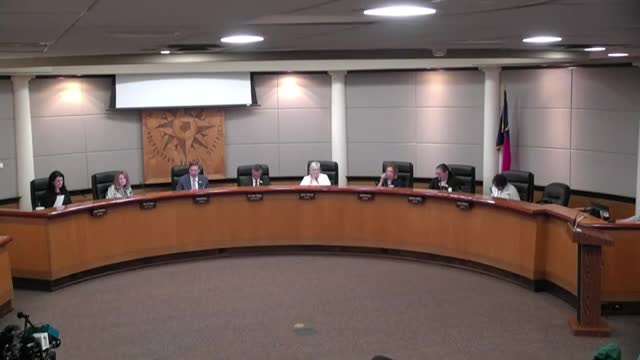NEISD presents bilingual/ESL evaluation; district sets targets to raise English outcomes by 2025–26
October 06, 2025 | NORTH EAST ISD, School Districts, Texas
This article was created by AI summarizing key points discussed. AI makes mistakes, so for full details and context, please refer to the video of the full meeting. Please report any errors so we can fix them. Report an error »

Northeast Independent School District staff told trustees on Wednesday that the district’s bilingual and English-as-a-second-language programs served about 13,460 students last year and account for roughly 20.74% of district enrollment, and they presented performance data and goals for the coming school year.
Senior Director Lisa Calderon led the annual bilingual/ESL program evaluation that Texas requires districts to present before Nov. 1. The presentation included proficiency results from TELPAS (Texas English Language Proficiency Assessment System), STAR reading results and internal targets for growth at elementary and secondary levels. “By the end of 2025–26, Northeast ISD secondary emerging bilingual students enrolled in ESL programs will increase ‘approaches grade level’ performance on the STAR reading assessment from 43% to at least 51%,” Calderon said, citing district goals.
Calderon outlined program structure: emerging bilingual students are placed in ESL or dual-language programs; the latter maintain the home language while developing English. She summarized staffing and certification: for 2024–25 the district reported 149 teachers working on a waiver; as of Sept. 24, 2025, 135 teachers were on an ESL waiver and 10 held bilingual exceptions, and 25 teachers from the earlier count were no longer with the district while 18 obtained certification. The district provides professional development and reimbursement for certification testing as required by TEA.
Trustees asked several clarifying questions. Board Secretary Thompson asked about state accountability targets for high-school STAR assessments; staff explained STAR targets are not set in the same way as other accountability measures. Trustee Landry asked whether “denials” — parents who decline bilingual or ESL services for their children — perform differently; Calderon said denials generally perform a bit below ESL students, and that teacher certification and classroom supports affect outcomes. Trustee Cox pressed on why ESL program results typically trail dual-language results; Calderon cited research showing dual-language maintenance of the home language supports later second-language academic outcomes and noted dual-language students are concentrated at specific campuses while ESL students are spread across 60-plus schools, creating challenges for consistent implementation.
Calderon walked trustees through TELPAS proficiency changes and explained the state is revising TOPAS/TELPAS measures in coming years, which affects targets and comparisons. She said reclassification (moving students out of the emergent bilingual label) occurs annually based on TOPAS and teacher recommendation, and that sometimes parents ask to keep students in dual-language programs after reclassification. The district’s next steps include semester monitoring, targeted interventions, continued professional development focused on content-based language instruction, and coaching to build capacity among general-education teachers who serve bilingual students.
Trustees thanked Calderon and requested continued updates. The presentation will be posted with board materials.
Senior Director Lisa Calderon led the annual bilingual/ESL program evaluation that Texas requires districts to present before Nov. 1. The presentation included proficiency results from TELPAS (Texas English Language Proficiency Assessment System), STAR reading results and internal targets for growth at elementary and secondary levels. “By the end of 2025–26, Northeast ISD secondary emerging bilingual students enrolled in ESL programs will increase ‘approaches grade level’ performance on the STAR reading assessment from 43% to at least 51%,” Calderon said, citing district goals.
Calderon outlined program structure: emerging bilingual students are placed in ESL or dual-language programs; the latter maintain the home language while developing English. She summarized staffing and certification: for 2024–25 the district reported 149 teachers working on a waiver; as of Sept. 24, 2025, 135 teachers were on an ESL waiver and 10 held bilingual exceptions, and 25 teachers from the earlier count were no longer with the district while 18 obtained certification. The district provides professional development and reimbursement for certification testing as required by TEA.
Trustees asked several clarifying questions. Board Secretary Thompson asked about state accountability targets for high-school STAR assessments; staff explained STAR targets are not set in the same way as other accountability measures. Trustee Landry asked whether “denials” — parents who decline bilingual or ESL services for their children — perform differently; Calderon said denials generally perform a bit below ESL students, and that teacher certification and classroom supports affect outcomes. Trustee Cox pressed on why ESL program results typically trail dual-language results; Calderon cited research showing dual-language maintenance of the home language supports later second-language academic outcomes and noted dual-language students are concentrated at specific campuses while ESL students are spread across 60-plus schools, creating challenges for consistent implementation.
Calderon walked trustees through TELPAS proficiency changes and explained the state is revising TOPAS/TELPAS measures in coming years, which affects targets and comparisons. She said reclassification (moving students out of the emergent bilingual label) occurs annually based on TOPAS and teacher recommendation, and that sometimes parents ask to keep students in dual-language programs after reclassification. The district’s next steps include semester monitoring, targeted interventions, continued professional development focused on content-based language instruction, and coaching to build capacity among general-education teachers who serve bilingual students.
Trustees thanked Calderon and requested continued updates. The presentation will be posted with board materials.
Don't Miss a Word: See the Full Meeting!
Go beyond summaries. Unlock every video, transcript, and key insight with a Founder Membership.
✓
Get instant access to full meeting videos
✓
Search and clip any phrase from complete transcripts
✓
Receive AI-powered summaries & custom alerts
✓
Enjoy lifetime, unrestricted access to government data
30-day money-back guarantee

